SHOCK- 2014 FLOAT iCD
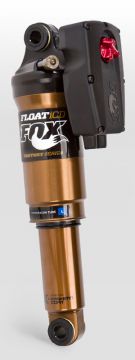
Travel
6.50 x 1.50
7.25 x 1.75
7.50 x 2.00
7.875 x 2.00
Features/Adjustments
Factory FLOAT iCD; Kashima Coated air sleeve and body, Electronic Climb/Descend mode, rebound, air spring pressure.
Spring
Air
Riding style
XC, Trail
Installing Your Shock
Check for clearance before riding.
If you are installing your shock on a bike for which the shock was not original equipment, follow the steps below to ensure proper clearance before riding.
- Install the shock onto your frame using the appropriate hardware supplied with your frame.
- Remove the air cap and let all air out of the main air chamber.
- Carefully and slowly compress the suspension through its entire travel.
- Check that no part of your shock contacts any portion of your frame or linkage as it cycles through its travel.
- Pressurize your main air chamber to between 50-300psi to prepare to set sag as described in the "Setting Shock Air Pressure" section below.
Before You Ride
Make sure that your shock is ready to ride
- Clean the outside of your shock with mild soap and water and wipe dry with a soft rag.
- Do not use any solvents or de-greasers as these products can damage the shock's exterior finish.
- Do not use a high pressure washer or spray water directly at the seal/shock body junction.
- Inspect the exterior of your shock. The shock should not be used if any of the exterior parts appear to be damaged
- Contact your local FOX dealer or FOX directly for further inspection or repair.
- Make sure that your quick-release levers (or thru-axles) are properly adjusted and tightened.
- Check your headset adjustment. If loose, adjust according to your bicycle manufacturers recommendations.
- Check that all brake cables or hoses are properly fastened.
- Test the proper operation of your front and rear brakes on lever ground.
Setting Shock Air Pressure
FLOAT iCD shocks have a maximum air pressure of 300psi
Sag should be set to 15 -€“ 20% of total shock travel
- Unscrew the black air cap to expose the schrader valve.
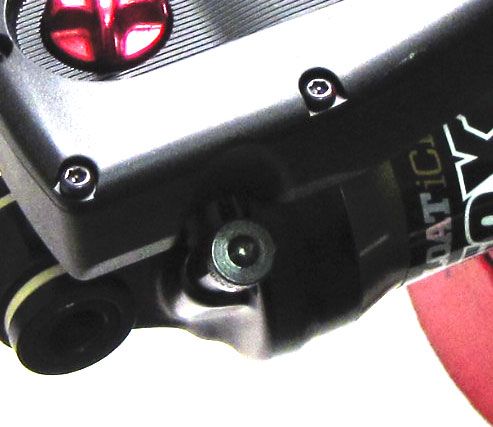
- Slide your shocks sag setting o-ring up against the shock dust wiper.

- Make sure that the iCD system is in Descend mode.
- Rotate switch up if mounted on the left side.
- Rotate switch down if mounted on the right side.
- Dressed to ride (including a filled hydration pack, if you use one), position your bike next to a wall or table to support yourself. Mount your bicycle. Assume your riding position for at least 10 seconds, allowing the suspension to fully settle. Make sure you distribute your weight evenly between the saddle, handlebars and pedals.
- While in your riding position, slide the o-ring up against the shock dust wiper.
- Dismount your bike without bouncing, to avoid further moving the o-ring. Measure the distance between the dust wiper and the o-ring. This is your sag measurement. Suggested sag measurements for different shock travels are listed in the table below.
- Add or remove air pressure until your sag measurement is between 15-20% of your shocks total travel.
- Repear steps 2-6 and recheck sag measurement.
- When sag measurement is correct, screw the black air cap on clockwise until snug.
| Suggested Sag Measurements | ||
| Shock Travel | 15% Sag (Firm) | 20% Sag (Plush) |
| 1.50 in./38mm | 0.23 in./5.7mm | 0.30 in./7.6mm |
| 1.75 in./44mm | 0.27 in./6.6mm | 0.35 in./8.8mm |
| 2.00 in./51mm | 0.30 in./7.6mm | 0.40 in./10.2mm |
Adjusting Rebound
Rebound controls how fast the shock extends after compressing
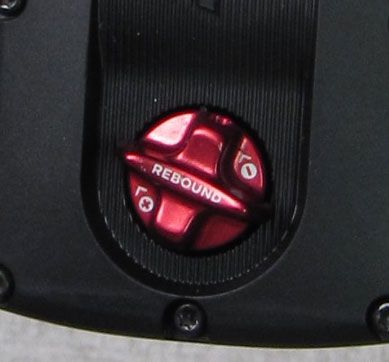
The red rebound knob is located in the center of the iCD motor unit. Rebound controls the rate of speed at which the shock extends after compressing. Turning the knob clockwise (in) slows down rebound, turning the knob counter-clockwise (out) speeds up rebound. Rebound damping should only be set after first setting your air pressure by measuring sag.
- Make sure that the iCD system is in Descend mode.
- Rotate switch up if mounted on the left side.
- Rotate switch down if mounted on the right side.
- Starting with the rebound adjuster in the fully open position (counter-clockwise) push down on the saddle to compress the shock and feel its return speed.
- Increase rebound damping by turning the red rebound knob clockwise until when tested, the shock returns quickly but does not top out.
Top out is felt when a shock fully extends too quickly and comes to an abrupt stop when it reaches full extension (you will hear/feel a small noise). Top out should be avoided through proper rebound setting.
Using the iCD System
Fast activation and almost effortless operation
iCD Pre-Installation Guide Download »
iCD Owner's Guide Download »
FLOAT iCD elevates cross country and trail riding to the next level. FLOAT iCD integrates an electronic actuated system into proven FOX FLOAT fork and shock designs, to quickly and optimally adjust between Climb and Descend modes.
This system offers fast activation and almost eff ortless operation. FLOAT iCD shares features with the Shimano E-Tube electronic shifting technology. FLOAT iCD uses Power-Line-Communication (PLC) that facilitates data and power flow through a single wire, permitting minimal wiring and ease of setup.
By default, the switch has a two position configuration, the same configuration as that most commonly used by FOX world class racers. For a full suspension setup, both fork and rear shock are actuated simultaneously. The switch can be operated by rotating it with your thumb using the thumb actuation indentation, or with the index finger actuation lever.
Climb Mode:
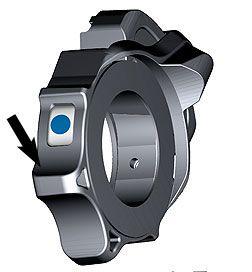
Rotating the switch down actuates climb mode for a right-mounted switch; if you have the switch mounted on the left side, rotating the switch up actuates climb mode. Climb mode is a very firm low-speed compression setting (not designed to be a solid lockout). This setting is most useful for climbing and sprinting.
Descend Mode:
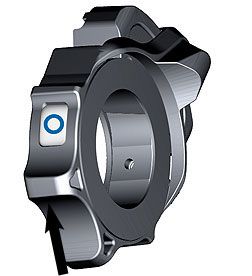
Rotating the switch up actuates descend mode; if you have the switch mounted on the left side, rotating the switch down actuates descend mode. Descend mode has the lightest low-speed compression damping of the two iCD modes. Descend mode offers the most plush ride to ensure optimal traction over varied terrain.
The Optional PC linkage device can be used to connect a PC to the bicycle (system or unit), and an E-tube Project* can be used to carry out tasks such as, problem diagnosis of single units and the whole system, updating firmware*, and customizing.
- * E-tube Project: the PC application
- * Firmware: the software inside each unit
The E-tube project application download can be found here: http://e-tubeproject.shimano.com
Service Intervals
Make sure to properly maintain your shock
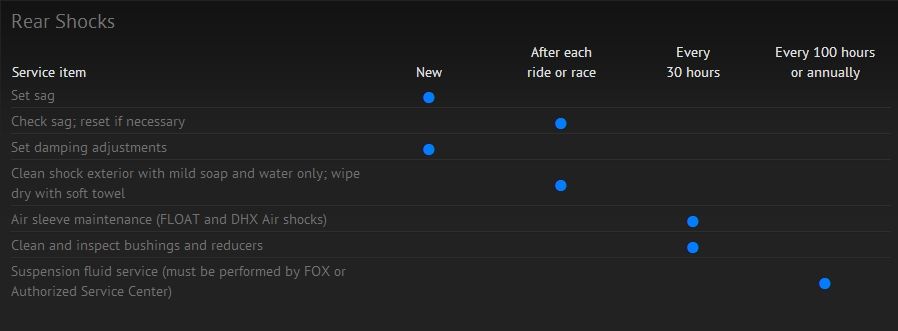
Air Sleeve Maintenance
The air seals inside FOX air shocks do a lot of work and should be replaced regularly in order to maintain optimal performance and prevent wear. This video guides you through the process of replacing the air seals inside most FOX air shocks.
